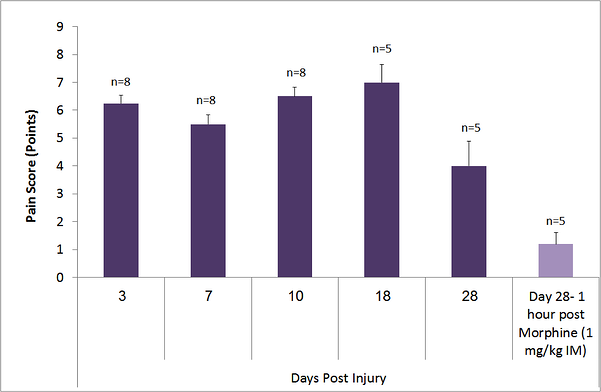Rodent models of pain such as nerve injury models are important to understand the mechanisms that may contribute to human neuropathic pain. Imaging studies in human have identified cortical regions specifically involved in the subjective, conscious perception of pain. Although laboratory animals process painful stimuli using similar mechanisms and thresholds of awareness as humans, it is much harder to assess the subjective pain experienced by animals as they can not self-report. This has led researchers to rely on objective measures of pain-related behaviors such as evoked responses to noxious stimuli. Humans, however, are able to voice discomfort, which provides rapid and direct access to the subjective experience.
MD Biosciences has been developing pig models for pain studies (post-operative and neuropathic pain) as the pig is becoming increasingly popular as an alterative model to dog or primate in both efficacy and toxicology studies. These models have the potential to add real value to the drug discovery process as they are phylogentically closer to the human than rodent, which is important at the molecular level, the CNS level, the metabolic level as well as the behavioral expressions of pain.
In both the post-operative pain model and the neuropathic pain model, subjective pain is assessed using a numerical rating scale (NRS) assessing the social behavior of the pig and the solitary performance. During the acclimation and habituation phase of the study, the pigs are trained and become accustomed to not only the penmates, but the observers and the caretakers in order to develop a baseline assessment of behavior. Under the conditions of the study, the social behaviors such as agression, isolation, restlessness and agitation are given a NRS score. Each pig is also rated on solitary performance which includes vocalization and appearance as well as parameters that are relevant to the type of pain condition (e.g. for the neuropathic pain model weight bearing and use of the leg are included).

Spontaneous pain behavior using 7 parameters in the pig model of neuropathic pain. The sum of all 7 parameters is given as the total score, with a maximum possible score as 11. The higher the score the more spontaneous behavior the animal expressed. on day 28, animals were dosed 1 mg/kg control (IM). One hour post administration, the animals spontaneous pain dropped by more than half, which is consistent with what is observed in the clinic (significant reduction in pain but not complete reversal).
Pain assessments in the Pig model of Neuropathic Pain:
- Von Frey test
- Sensitivity to feather (also used as a yes/no indication in the clinic)
- Spontaneous/subjective Pain
- Motor Function
Combining the standard objective measures of pain with subjective measures of pain brings further value to translating preclinical results to the clincal situation. We propose that this pig model of neuropathic pain will aid researchers in the development of new therapeutic agents.





